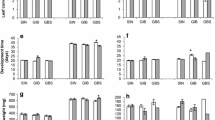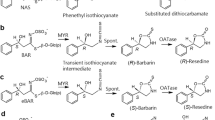Abstract
Sinalbin was identified as a chemical component of insect anti-xenosis and antibiosis resistance mechanisms in seedlings ofSinapis alba by DEAE-Sephadex chromatography, HPLC, treatment with sulfatase and myrosinase, various feeding tests using artificial and natural substrates, and by measuring sinalbin concentrations in cotyledons and leaves during seedling development. The effects of sinaibin on feeding were dependent upon the insect species and upon the rapidly changing profile of sinaibin concentrations in the developing seedling. The high concentrations of sinalbin found in young cotyledons (up to 20 mM) and leaves (up to 10 mM) deterred the feeding of the flea beetle,Phyllotreta cruciferae Goeze and larvae of the bertha armyworm,Mamestra configurata Walker. The protection that sinalbin confers upon the vulnerable, newly emerged seedling (and upon tiny, young leaves) appears critical for the first few days of survival ofS. alba under feeding pressure from flea beetles in the field. The lower concentrations of sinaibin found in older cotyledons and leaves (2–3 mM) offer little or no protection againstP. cruciferae and may actually stimulate the feeding of this crucifer specialist. These concentrations of sinaibin, however, are still effective in reducing the level of feeding by larvae of the more generalist feederM. configurata.
Similar content being viewed by others
References
Beirne, B.P. 1971. Pest insects of annual crop plants in Canada.Mem. Entomol. Soc. Can. 78.
Bodnaryk, R.P., andLamb, R.J. 1991. Mechanisms of resistance to the flea beetle,Phyllotreta cruciferae (Goeze) in mustard seedlings,Sinapis alba L.Can. J. Plant Sci. 71:13–20.
Bodnaryk, R.P., andPalaniswamy, P. 1990. Glucosinolate levels in the cotyledons of mustard,Brassica juncea L. and rape,B. napus L. do not determine feeding rates of the flea beetle,Phyllotreta cruciferae (Goeze).J. Chem. Ecol. 16:2735–2746.
Bones, A.M. 1990. Distribution of beta-thioglucosidase activity in intact plants, cell and tissue cultures and regenerate plants ofBrassica napus L.J. Exp. Bot. 41:737–744.
Bucher, G.E., andBracken, G.K. 1976. The bertha armyworm,Mamestra configurata (Lepidoptera: Noctuidae): Artificial diet and rearing technique.Can. Entomol. 108:1327–1338.
Burgess, L., andWiens, J.E. 1980. Dispensing allyl isothiocyanate as an attractant for trapping crucifer-feeding flea beetles.Can. Entomol. 112:93–97.
Chew, F.S. 1988. Searching for defensive chemistry in the cruciferae, or, do glucosinolates always control interactions of cruciferae with their potential herbivores and symbionts? No. 1, pp. 81–112,in K.C. Spencer (ed.). Chemical Mediation of Coevolution. Academic Press, Toronto.
Hanley, A.B., Heaney, R.K., andFenwick, G.R. 1983. Improved isolation of glucobrassicin and other glucosinolates.J. Sci. Food Agric. 34:869–873.
Lamb, R.J. 1984. Effects of flea beetle,Phyllotreta spp. (Chrysomelidae: Coleoptera), on the survival, growth, seed yield and quality of canola, rape and yellow mustard.Can. Entomol. 116:269–280.
Larsen, P.O. 1981. Glucosinolates, pp. 501–525,in E.E. Conn (ed.). The Biochemistry of Plants, Vol. 7. Academic Press, Toronto.
Minchinton, I., Sang, J., Burke, D., andTruscott, R.J.W. 1982. Separation of desulphoglucosinolates by reversed-phase high performance liquid chromatography.J. Chromatogr. 247:141–148.
Painter, R.H. 1951. Insect Resistance in Crop Plants. University of Kansas Press, Lawrence, Kansas.
Putnam, L.G. 1977. Response of four Brassica seed crop species to attack by the crucifer flea beetle,Phyllotreta cruciferae.Can. J. Plant Sci. 57:987–989.
Reed, D.W., Pivnick, K.A., andUnderhill, E.W. 1989. Identification of chemical oviposition stimulants for the diamondback moth,Putella xylostella, present in three species of Brassicaceae.Entomol. Exp. Appl. 53:277–286.
Ripley, V.L., andArnison, P.G. 1990. Hybridization ofSinapis alba L. andBrassica napus L. via embryo rescue.Plant Breed. 104:26–33.
Rodman, J.E. 1981. Divergence, convergence, and parallelism in phytochemical characters: The glucosinolate-myrosinase system, pp. 43–79,in D.A. Young and D.A. Seigler (eds.). Phytochemistry and Angiosperm Phytogeny. Praeger, New York.
Turnock, W.J. 1985. Developmental, survival, and reproductive parameters of bertha armyworm,Mamestra configurata (Lepidoptera: Noctuidae) on four plant species.Can. Entomol. 117:1267–1271.
Author information
Authors and Affiliations
Rights and permissions
About this article
Cite this article
Bodnaryk, R.P. Developmental profile of sinalbin (p-hydroxybenzyl glucosinolate) in mustard seedlings,Sinapis alba L., and its relationship to insect resistance. J Chem Ecol 17, 1543–1556 (1991). https://doi.org/10.1007/BF00984687
Received:
Accepted:
Issue Date:
DOI: https://doi.org/10.1007/BF00984687




